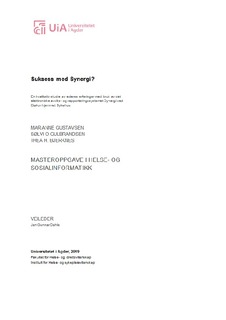| dc.contributor.author | Gustavsen, Marianne | |
| dc.contributor.author | Gulbrandsen, Sølvi O. | |
| dc.contributor.author | Bjerknes, Thea H. | |
| dc.date.accessioned | 2019-09-19T11:06:41Z | |
| dc.date.available | 2019-09-19T11:06:41Z | |
| dc.date.issued | 2019 | |
| dc.identifier.uri | http://hdl.handle.net/11250/2617648 | |
| dc.description | Masteroppgave helse- og sosialinformatikk HSI500 - Universitetet i Agder 2019 | nb_NO |
| dc.description.abstract | Introduction: Information and communication technology is constantly evolving in health care.. Digitization are of high priority within healtcare and the ICT are ment to contribute to raise the quality of healtcareservices. The hospitals incident reporting systems, where one are able to register, analyze and process unwanted incidents, are a key tool for fulfilling the requirements to controlsystems according to regulations regarding management and improvement of the quality in healthcare. Purpose: The purpose of the studyis to investigate and describe the experiences different leaders (Head of unit) have with the electronic incident and reporting system, Synergi.Selection and methodology: A qualitative study has been carried out at Diakonhjemmet sykehus, which is based on eight semi-structured interviews with leaders (Head of unit or assistant managers), all with experience as caseworkers in the electronic incident and reporting system, Synergi. The Interview Guide is based on the categories from DeLone and McLean (2003) IS Success Model and the successatributes of van der Meijden (2003). Results:The informants have been employed as leaders for at least one year, and been having a function as caseworkers for the past year. There is a variation in use of the system. The informants have different views regarding information quality, yet the information appears to be influenced by choices and how the incidents have been registered within the system as well as the amount of information requested. Systemquality is in some wayschallenged by functions within the system that creates extra work and inadequate functions, which can lead to use of other systems to get a better overview. Despite this the informants finds, among other things, the system useful as a tool for support andto get an overview, which can facilitate learning by using information from the system together with the employees in different forums.Conclusion: Apparently, leaders may experience partial success related to the electronic incident reporting system Synergi. However, there are several challenges that makes the experience of the system not as intuitive. A greater focus on training for both casemangers and the employees that reports within the system will possibly increase the competence and a better usersatisfaction. | nb_NO |
| dc.language.iso | nob | nb_NO |
| dc.publisher | Universitetet i Agder ; University of Agder | nb_NO |
| dc.rights | Attribution-NonCommercial-NoDerivatives 4.0 Internasjonal | * |
| dc.rights.uri | http://creativecommons.org/licenses/by-nc-nd/4.0/deed.no | * |
| dc.subject | HSI500 | nb_NO |
| dc.title | Suksess med synergi : en kvalitativ studie av lederes erfaringer med bruk av det elektroniske avviks- og rapporteringssystemet Synergi ved Diakonhjemmet Sykehus | nb_NO |
| dc.type | Master thesis | nb_NO |
| dc.subject.nsi | VDP::Teknologi: 500::Informasjons- og kommunikasjonsteknologi: 550 | nb_NO |
| dc.subject.nsi | VDP::Samfunnsvitenskap: 200::Statsvitenskap og organisasjonsteori: 240::Offentlig og privat administrasjon: 242 | nb_NO |
| dc.source.pagenumber | 130 s. | nb_NO |

